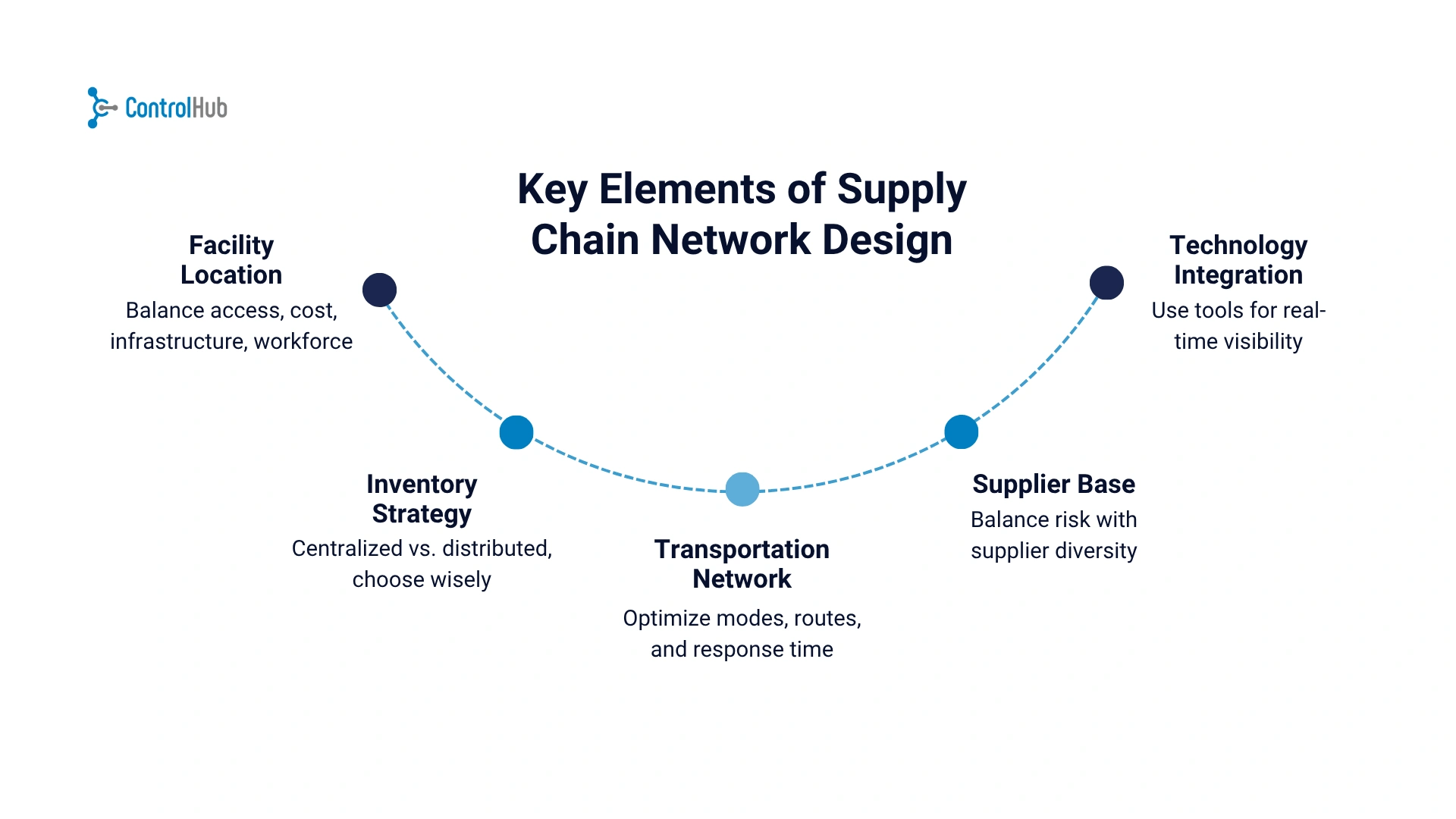Free Supplier Risk Scorecard Download
Download our free supplier risk scorecard here!
Download the free tool!AI Summarize:
Go to Reddit and do a quick search of what people working in supply chains are commenting the most about.
Spoiler?
Problems
The slightest mention of a potential natural disaster puts companies in panic mode. Markets are harder to predict, and even growing becomes a concern when you don't know with certainty how you are going to manage all the data.
So yes…you could say supply chain network design is the hot topic of today and the next day.
What's Supply Chain Network Design?
There's a chance you have heard it somewhere.
Supply chain network design is the route, the map, and the plan you create and continuously check on to make sure your business's goods move from your location to your final customers.
So it's process-oriented?
Yes, and at the same time, it's much more; you literally need to set the best route to get your products moving.
Focusing on questions like…
- What's the most convenient location for your facilities?
- What's the ideal space required in your warehouses?
- Can the location of your suppliers seriously impact your logistics?
- Who's handling the shipping?
As a strategic approach, supply chain network design helps you to deliver goods, balancing costs, time, and quality 24/7
And in case you are wondering, yes, that has a 360-degree impact on the rest of your company's operations. Laying the groundwork for smarter procurement decisions, better inventory placement, and more agile logistics
Why Network Design Matters More Than Ever
Impact of disruptions
(pandemics, geopolitical shifts, climate events).
Not to be dramatic or anything, but we can divide our recent story into two main chapters.
Pre-COVID and post-COVID
While the days of the pandemic are long gone, its consequences have remained with businesses across the globe.
That's without mentioning current issues like climate change, natural disasters, political uncertainty, and even whispers of military conflict.
So yes…disruptions can happen at any time.
A well-designed network gives you options, backup suppliers, alternate routes, and faster reaction times.
Growing pressure for sustainability and compliance.
Ask procurement and supply chain professionals about their biggest challenges. And we guarantee that you'll find an increase in regulations as part of the list.
Our world is advancing at giant steps, hence the need to tighten regulations and compliance requirements. Whether it’s emissions targets, ethical sourcing, or labor transparency, your network has to support these goals from the very beginning.
Skip it and you'll pay dearly.
No, it's not pessimism.
It's a fact
Not designing your supply chain network can put your company at serious risk.
Do the design once and forget about it?
Also dangerous
Outdated designs lead to high transportation costs, inventory pileups, poor service levels, and zero agility.
Worse? You often won’t realize it’s broken until something goes wrong
Link to competitive advantage and profitability.
Let's be bluntly honest.
It doesn't matter how great your product or service is.
What matters is what your customers think.
The way your supply chain behaves and acts under pressure has a great influence on it.
In markets where margins are tight and expectations are high, that kind of power can make a huge difference.
Free Supplier Risk Scorecard Download
Download our free supplier risk scorecard here!
Download the free tool!Key Elements of Supply Chain Network Design
Facility location
Yes, yes, we live in a super globalized world.
Maybe that's why it's more important than ever to really consider where you place your warehouses, plants, and distribution centers. You want an accessible location, that's for sure, but you don't want to pay thousands of dollars just for a place next to you.
Proximity to suppliers, tax implications, transportation infrastructure, and workforce availability all factor in. Pick wrong, and you could be dealing with inefficiency for years.
Inventory strategy
The way you handle your inventory can usually be approached either by centralizing the majority of your stock in a single place or by working with multiple distribution centres, so shipping to different locations is simpler.
There's no right method to manage your inventory, but it's a good idea to pause and fully consider which one works the best for your company.
Transportation network
mode choices, route optimization.
It's not only about where your goods are stored. Another big factor lies in the methods you use to make things move.
Sea? Air? Roads?
When designing this part, don't forget to evaluate which alternative meets all your criteria in terms of costs and efficiency (speed, response time)
Supplier base
How many suppliers do you really need?
Relying on a single supplier might save money in the short term, but it also increases your exposure to disruption. Hence, the popularity of supplier diversity
On the flip side, managing too many unnecessary options can get messy fast.
Network design helps you balance resilience and complexity with strategic sourcing decisions.
Technology integration
Because it's kind of difficult to work these days without a bit of digital support.
Think of simulation tools, visibility platforms, and advanced planning software.
All those systems have been built to guide you with real-time visibility when you most need it.
Free Supplier Risk Scorecard Download
Download our free supplier risk scorecard here!
Download the free tool!Step-by-Step Process for Designing a Supply Chain Network
Step 1:Define goals and constraints.
Are you trying to cut transportation costs? Improve delivery speed? Increase resilience? Align this with internal goals like ESG targets or cost-to-serve benchmarks.
On the flip side, define your constraints; maybe certain regions are off-limits due to regulations, or it just doesn't make sense for your current business situation.
Knowing your limits is just as important as knowing your goals.
Step 2: Map the current network.
Start with what you have: where your facilities, suppliers, and customers are, how goods flow between them, and what modes of transport you use.
Step 3: Gather and analyze data.
- Product volumes and flows
- Transportation and warehousing costs
- Lead times and service levels
- Demand patterns by region
Step 4: Model different scenarios.
This is the fun part.
And you don't have to do it alone. Nowadays, there are some programs in the market capable of helping you to see how your supply chain would react to different scenarios.
Step 5: Evaluate trade-offs
No network gets everything perfect on the first try.
A cheaper option may increase lead times; a more resilient one may cost more upfront.
Put the scenarios side by side and weigh them against your priorities. This is often where alignment between logistics, procurement, and finance teams is critical.
Step 6: Implement and monitor.
Build a roadmap for implementation, monitor performance metrics post-launch, and treat network design as a living process, not a one-off project.
The Lesson
Supply chain network design it’s a critical, ongoing process that shapes how efficiently and resiliently your entire operation runs. Whether you’re scaling fast, trying to cut costs, or bracing for the next disruption, your network is either helping you or holding you back.
If you haven’t looked at your design in a while, now’s the time. Map what you’ve got, model some scenarios, and start making decisions that align with where your business is going, not where it’s been.
Better design = better performance. It’s that simple.
Free Supplier Risk Scorecard Download
Download our free supplier risk scorecard here!
Download the free tool!Free Supplier Risk Scorecard Download
Download our free supplier risk scorecard here!
Download the free tool!%20(1).avif)



.webp)

.webp)











.png)


